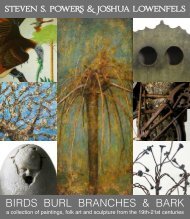INSIDER / OUTSIDER
The definition of Outsider Art is fraught with issues—as online trolls will attest—and, I will not attempt to define it here. However, to further confuse the issue, I will bring forth a few of what I would call “insider/outsider” artists such as Forrest Bess, Frank Overton Colbert, Ida Jones and John Roeder. Individuals that are hard to pigeonhole and overlap with Outsider, Folk, Self-taught, and schooled artists. Can an artist be an “outsider” if you they had some instruction, but have a minority’s perspective? Are all outsider artists self-taught? If they spent time in a mental institution are they automatically an “outsider?” Can one be an “outsider” if they were on the fringe of society, but then thrust into the New York gallery scene and continued to create art that was then for resale? As with most things, a case-by-case examination and identification of context is key to aiding any definition (if one must be so defined). In the following pages, we will present a number of artists and works of art that overlap, transition or fit by context into this insider/outsider scheme. In addition. we will have works by Dilmus Hall, George Morgan, Henry Speller, George Ohr, Eugene Andolsek, Henry Ray Clark and others. January 18-21, 2018. Metropolitan Pavilion, 125 W 18th St, New York, NY 10011
The definition of Outsider Art is fraught with issues—as online trolls will attest—and, I will not attempt to define it here. However, to further confuse the issue, I will bring forth a few of what I would call “insider/outsider” artists such as Forrest Bess, Frank Overton Colbert, Ida Jones and John Roeder. Individuals that are hard to pigeonhole and overlap with Outsider, Folk, Self-taught, and schooled artists.
Can an artist be an “outsider” if you they had some instruction, but have a minority’s perspective? Are all outsider artists self-taught? If they spent time in a mental institution are they automatically an “outsider?” Can one be an “outsider” if they were on the fringe of society, but then thrust into the New York gallery scene and continued to create art that was then for resale? As with most things, a case-by-case examination and identification of context is key to aiding any definition (if one must be so defined).
In the following pages, we will present a number of artists and works of art that overlap, transition or fit by context into this insider/outsider scheme. In addition. we will have works by Dilmus Hall, George Morgan, Henry Speller, George Ohr, Eugene Andolsek, Henry Ray Clark and others.
January 18-21, 2018.
Metropolitan Pavilion, 125 W 18th St, New York, NY 10011
Create successful ePaper yourself
Turn your PDF publications into a flip-book with our unique Google optimized e-Paper software.
i n s i d e r<br />
outsider/><br />
outsider art fair new york<br />
january 18-21,2018
S T E V E N S . P O W E R S<br />
<br />
The definition of Outsider Art is fraught with issues—as online trolls<br />
will attest—and, I will not attempt to define it here. However, to<br />
further confuse the issue, I will bring forth a few of what I would call<br />
“insider/outsider” artists such as Forrest Bess, Frank Overton<br />
Colbert, Ida Jones and John Roeder. Individuals that are hard to<br />
pigeonhole and overlap with Outsider, Folk, Self-taught, and<br />
schooled artists.<br />
Can an artist be an “outsider” if you they had some instruction, but<br />
have a minority’s perspective? Are all outsider artists self-taught? If<br />
they spent time in a mental institution are they automatically an<br />
“outsider?” Can one be an “outsider” if they were on the fringe of<br />
society, but then thrust into the New York gallery scene and<br />
continued to create art that was then for resale? As with most<br />
things, a case-by-case examination and identification of context is<br />
key to aiding any definition (if one must be so defined).<br />
In the following pages, we will present a number of artists and<br />
works of art that overlap, transition or fit by context into this<br />
insider/outsider scheme. In addition, we will have works by<br />
Dilmus Hall, George Morgan, Henry Speller, George Ohr, Eugene<br />
Andolsek, Henry Ray Clark and others.<br />
January 18-21, 2018.<br />
Metropolitan Pavilion, 125 W 18th St, New York, NY 10011<br />
additional show information: outsiderartfair.com<br />
W O R K S O F<br />
A R T<br />
& a m e r i c a n a<br />
109 3rd Place #2, Brooklyn, NY 11231 | 718.625.1715 or 917.518.0809 | stevenspowers.com | member: ADA
Ida Jones (1874-1959)<br />
Parable of the Wise and Foolish Virgins (detail)<br />
Oil on canvas board<br />
Circa: 1945<br />
Size: 17 1/4" (w) x 13 1/2" (h)
Frank Overton Colbert (1895-1953)<br />
The Trail to Happy Hunting Ground<br />
Oil on canvas board<br />
Circa: 1922<br />
Size: 16" (w) x 14" (h)<br />
Exhibited: Architectural League of<br />
New York, 37th Annual Exhibition,<br />
Fine Arts Building, New York, NY.<br />
February 5 - March 4, 1922 (label on<br />
back). Listed as number 522, page 16<br />
in catalog.<br />
“Indian Folk Lore Pictures,” Montross<br />
Gallery, New York, NY. January 5-20,<br />
1923. Listed as number 11 on<br />
exhibition checklist.<br />
Published: Evening Star (Washington,<br />
District of Columbia), Sunday, March<br />
19, 1922, Page 70. Colbert is shown<br />
in Indian dress with this painting at<br />
lower right.
You likely have not heard of Frank Overton Colbert, and you don’t have to<br />
pretend like you have. I hadn’t nor had any of my colleagues, but when I saw<br />
the burial image on the previous page, I immediately needed to know<br />
everything about it and who painted it—what I learned was extraordinary.<br />
In 1895, Frank Overton Colbert was born to a distinguished line of Chickasaw<br />
Indian leaders in Riverside, Oklahoma. His father, Holmes Colbert, co-wrote<br />
the Chickasaw Nations constitution and was for a time its delegate to DC. His<br />
prosperous father wished for him to pursue politics, however, Colbert was<br />
bitten by art and in 1916 he pursued a path that lead him to explore the<br />
Southwest and the Pacific coast. In 1917, he enlisted in the navy and worked in<br />
the camouflage department. After being discharged, Colbert moved to<br />
Greenwich Village, NYC to get serious about painting.<br />
Upon his arrival in New York,<br />
the roaring twenties had just<br />
begun and artists, writers, and<br />
musicians flocked to the city,<br />
where it was ripe with avantgarde<br />
energy. Colbert being a<br />
Chickasaw Indian brought an<br />
exotic interest into his cadre of<br />
artist friends and provided<br />
authenticity to the “Inje-Inje”<br />
movement his friend, Holger<br />
Cahill was trying to lift off the<br />
ground—which was aimed to be<br />
a “hell-broth of neoprimitivism.”<br />
This exposure found Colbert<br />
exhibiting a series of “Indian<br />
Folk Lore” paintings with the<br />
Photo of Colbert pointing to his work—the painting herein<br />
is to the lower right. The Evening Star (Washington, DC),<br />
March 19, 1922, p. 70.
highly reputable and progressive Montross Gallery in 1921 and 1923.<br />
As was de rigueur for the time, Colbert traveled to Paris in 1923. Though<br />
Colbert exhibited at the Salon d’Automne and later at the Society of<br />
Independent Artists, he never found the success in Paris that he had in NY.<br />
In Paris, Colbert was known as Redfeather, and dressed up as an Indian<br />
stereotype and sold drawings done on butcher’s paper outside the cafes. After a<br />
breakdown and a stay at a sanitarium, he returned to NYC only to continue<br />
having bouts of delusional paranoia. By 1941 he was committed to a VA<br />
Hospital in Fort Lyons, Colorado and died there 12 years later in 1953.<br />
The painting, The Trail to Happy Hunting Ground, shows a traditional open-air,<br />
scaffold burial, popular among a number of North American Indian cultures,<br />
including the Sioux who termed the afterlife<br />
the “happy hunting ground.” The body<br />
is tightly wrapped in cloths and raised<br />
upon a scaffold to protect the deceased<br />
from animals and offered to the “Great<br />
Spirit.” An owl appears in the tree,<br />
camouflaged. The owl was both feared and<br />
revered throughout Native cultures as an<br />
omen of death and one with clear thoughts<br />
and vision—it was also seen as a<br />
messenger between worlds.<br />
Colbert’s whole ouevre deserves fresh eyes<br />
and examination, as he sits on the edge of<br />
many overlapping interests including early<br />
Modernism, Native American fine art and<br />
Outsider Art.<br />
Photo of Native American Burial Site by<br />
Cree Indian Richard Throssel (1882-1933).
Spirit Drawing<br />
Slate, chalk<br />
Circa: 1900<br />
Size: 6 1/4" (w) x 10" (h)<br />
Portrait of a man on slate with a message from<br />
beyond in red chalk. Transcription below.<br />
“Dear Caran(?), Possessor of Earth Life, again I<br />
reach out from the Land of Souls to you my dear ---<br />
of earth, I bring to you the joy and comfort and<br />
health and peace of mind that you need in old age,<br />
but you are just ripening like the beautiful fruit --<br />
and the orchard by and by gravitate to when you<br />
belong to the Shores of Eternal Bliss and happiness,<br />
be of good cheer for I will receive you into<br />
the summer C---- with upon --- and bid you<br />
welcome to our heaven (?) over him and to be again<br />
as our whole family never --- to part. For my love<br />
for you has grown in its purity and as a Husband<br />
and Father I pray aimed a --- for you all angels.<br />
Bless you, for I am always with you, Smith Stehl”
Paul Bowen<br />
Sole Ball<br />
antique shoe leathers, wood, nails<br />
Circa: early 1980’s<br />
Size: 14 1/2" (d)
Forrest Bess (1911 – 1977)<br />
Untitled [Three Figures]<br />
Oil on canvas<br />
Circa: 1946<br />
Size: 16" (w) x 14" (h)<br />
Provenance: Kirk Hopper Fine Art, Parrasch Heijnen Gallery.<br />
In 1946 Forrest Bess found himself as a painter. Although Bess had<br />
produced works in the 1930’s, it was not until 1946 that Bess, at<br />
the urging of his psychiatrist had he began to record the colorful<br />
visions that were troubling him. The visions were likely brought on<br />
from the trauma he suffered from being beaten by a fellow Army<br />
mate as a consequence of his homosexuality. In this year, Bess<br />
produced a wide range of work; representational, abstract and<br />
symbolic paintings. About this period, Bess expressed to his dealer,<br />
Betty Parsons, “Only by painting the goddamned thing out have all<br />
my symptoms of anxiety disappeared.” It was these works that got<br />
him through his PTSD and on his way to the visionary painter he<br />
would become.<br />
Bess’s paintings were an integral part of his being which was<br />
heavily influenced by Carl Jung’s thoughts on symbolism,<br />
Australian aboriginal initiation rites and the belief that the<br />
hermaphrodite was “the desired and intended state of man.” His<br />
commitment to this philosophy culminated in the self-surgery on<br />
his genitals in the late 1950’s.
“All my life I have been an<br />
outsider looking at beauty”<br />
— Forrest Bess to Betty Parsons
Among the works created in 1946 are three related figural works.<br />
The painting herein, one from the esteemed Harry Burkhart<br />
Collection, and another in a private collection.<br />
The three works were likely produced in quick succession, one<br />
after the other. They each have groups of solidly painted figures<br />
that define the space and foreboding environments. The moody<br />
works are punctuated with blocks of primary and secondary<br />
colors—they are surely direct responses to the colorful visions and<br />
trauma that Bess had discussed with his therapist.<br />
In the untitled work herein, two figures have cornered a third—it<br />
feels like an act of violence is about to occur. The reddish figure<br />
appears defensive and raises his left arm to push away the two blue<br />
beings closing in on him. Though flatly rendered the figures have a<br />
keen sense of form and movement.<br />
Though Bess would become widely known for his visionary works<br />
and show at the Betty Parsons Gallery alongside Mark Rothko and<br />
Jackson Pollock, it was through the figural works of 1946 that<br />
allowed Bess to free himself and explore his symbolic work.<br />
Forrest Bess was the subject of a retrospective at the Hammer<br />
Museum in 2013/2014 and was featured in the 2012 Whitney<br />
Biennial. His work is part of numerous museum and private<br />
collections, including the Menil Collection, Houston, the Museum<br />
of Contemporary Art, Chicago, Museum of Modern Art in New<br />
York, and Whitney Museum of American Art in New York.
“ONLY BY PAINTING THE<br />
goddamned thing out have<br />
all my symptoms of anxiety<br />
disappeared.”<br />
— Forrest Bess to Betty Parsons<br />
Photo of Bess from,<br />
"His Name Was Forrest<br />
Bess" by Michael Ennis,<br />
Texas Monthly, June 1982<br />
Undated photo of Bess at his<br />
house/studio in Chinquapin,<br />
Texas.
Sun-face Bird House<br />
Eastern Pennsylvania<br />
Wood, tin, paint<br />
Circa: 1930-1940<br />
Size: 12" (diameter) x 5"<br />
(deep)<br />
Provenance: Aarne Anton,<br />
Ricco / Maresca, Marvill<br />
Collection<br />
Literature: The Clarion,<br />
Spring 1988, p.4
Ida Jones (1874-1959)<br />
Parable of the Wise and Foolish Virgins<br />
Oil on canvas board<br />
Circa: 1945<br />
Size: 17 1/4" (w) x 13 1/2" (h)<br />
Ida Jones, the daughter of a former slave, had ten children and at the<br />
age of seventy-two began painting. Self-taught, her work focuses on<br />
local (Chester County, PA) landscapes, still-lifes and Biblical stories.<br />
The Parable of the Wise and Foolish Virgins is told in the Gospel of<br />
Matthew 25:1-13, whereas the five virgins who are prepared for the<br />
groom's arrival are rewarded, while the five who are not prepared are<br />
disowned. The point being, be prepared (for Judgment Day)!<br />
The Chester County Historical<br />
Society held a retrospective exhibit<br />
in 1995 and Jones was recently<br />
included in “We Speak: Black<br />
Artists in Philadelphia, 1920s-<br />
1970s, ” 2015.<br />
Literature: Starting Anew After<br />
Seventy: The Story of Ida Ella<br />
Jones, Primitive Artist, by Ida J.<br />
Williams, 1980.<br />
Photo of Jones in her studio, circa 1955.<br />
To Everything a Season: The Art<br />
and Life of Ida Jones, by Beverly<br />
Sheppard and Roberta Townsend, 1995.
Dilmus Hall (1900-1987)<br />
Figure Seated on a Bench<br />
Wood, wood putty, metal, beads, paint<br />
Circa: 1982-1983<br />
Size: 13" (h) x 10" (w) x 5" (d)<br />
Provenance: Roger Ricco, Marvill Collection<br />
Pictured and discussed in American Primitive, p. 241, fig. 346.<br />
As a child Hall would fashion small sculptures made from flour mixed<br />
with tree sap. Discouraged by his father, he didn’t pursue art until later<br />
in life.<br />
After serving in WWI as a stretcher bearer, he returned to Georgia and<br />
worked as a hotel bell captain, a sorority house busboy and then as a<br />
fabricator of concrete blocks for a construction company. It was here<br />
that Hall found himself again—<br />
working with his hands.<br />
He began making concrete sculpture<br />
around his home. His sculpture<br />
combined a mix of Christianity with<br />
an African conjuring culture that<br />
empowered objects with protective<br />
powers. Later he would make little<br />
tableau such as the example seen<br />
herein that recall the modeling<br />
technique he developed as a child.<br />
Still image from the documentary, The<br />
Mind's Eye, with Hall at his home, circa<br />
1987.
Mirrored Mermaid<br />
Wood, paint, caulk, mirror slivers<br />
Circa: 1920-1930<br />
Size: 40 1/2" (h) x 15" (w) x 8 1/2" (d)<br />
A mysterious fish-tailed figure constructed of<br />
plywood and inlaid with hundreds of mirror<br />
slivers. The head is irregularly shaped, more fish<br />
or alien than human. But, the body is slender and<br />
anthropomorphic with broad shoulders and thin<br />
arms. A wave at the base makes it look as if the<br />
figure is emerging from the water.<br />
Though its original purpose or creator has been<br />
lost to time, it remains a compelling and<br />
beautiful sculpture.
John Roeder (1877-1964)<br />
The Traveling Observatory<br />
Oil on canvas<br />
Circa: 1950<br />
Size: 14 5/8" (h) x 14 3/16" (w)<br />
Born in Luxembourg, Roeder moved Richmond, CA in 1909 with<br />
his wife and children. Roeder worked as a pipe fitter for many years<br />
and then as a gardener for the local High School.<br />
In his downtime, Roeder taught himself to paint and sculpt using<br />
found materials and inexpensive paints.<br />
The Traveling Observatory has all the elements of a complex<br />
Roeder; fantasy, mystery, humor and great trees. A man stands<br />
holding the reins of a horse-drawn<br />
carriage that then becomes a<br />
landscape of switchback trees and<br />
fences upon which two men with<br />
telescopes sit on a see-saw. At the<br />
top of this landscape are snowy<br />
white mountains with numerous<br />
moons or planets in the distant sky.<br />
Though the bulk of Roeder’s oeuvre<br />
are paintings, he did some foundmaterial<br />
sculpture and large-scale<br />
concrete sculpture for his home en-<br />
Photo of John Roeder by Imogen<br />
Cunningham, 1961
vironment. The sculpture<br />
herein, entitled “Hand, Tooth<br />
& Foot” uses carved and found<br />
elements. The hand reminds<br />
me of an antique baseball<br />
glove.<br />
In 1961, The Richmond Art<br />
Center held a large<br />
retrospective of Roeder’s work,<br />
where the photographer<br />
Imogen Cunningham<br />
photographed him among his<br />
sculpture.<br />
Photo of John Roeder by Imogen Cunningham, 1961<br />
In 1962, the town of Richmond razed his home and gardens to<br />
make way for a public building.<br />
John Roeder (1877-1964)<br />
Hand, Tooth & Foot<br />
Wood<br />
Circa: 1950<br />
Size: 17" (h) x 12" (w) x 7" (d)<br />
Exhibited: Richmond Art Center,<br />
Richmond, CA, 1960 from the<br />
collection of Vincent Porcaro.
Crockery Cacophony<br />
Southeast Asia, Cambodia<br />
Stoneware<br />
Circa: 12-14th century<br />
Size: 13" (h) x 16 1/2" (w)<br />
Provenance: Doris Wiener Gallery, 1981.<br />
An artful incidence of ancient Khmer vases, vessels and<br />
celadon bowls haphazardly fused together. An<br />
exhilarating work on the round—like a George Ohr /<br />
Peter Voulkos mash-up!!
James W. Washington, Jr. (1909-2000)<br />
Bird Family<br />
Black granite, redwood burl<br />
Dated: 1973<br />
Size: 12 1/4" L x 8 1/8" D x 7 1/2" H<br />
Exhibited at: Bellevue Art Museum, Bellevue, WA, "The Spirit in the<br />
Stone: The Visionary Art of James W. Washington, Jr." March 10 -<br />
April 16, 1989.<br />
Bird Family is a large work of a mother bird protecting and feeding<br />
three nestlings under her wing. The solid black granite<br />
metaphorically reinforces the strength of the matriarch, while<br />
Washington's sensitive carving conveys a certain intimacy and the<br />
fragility of life.<br />
James W. Washington, Jr. was an<br />
African-American, self-taught<br />
artist. Born in Gloster,<br />
Mississippi, Washington settled<br />
in Seattle as a government electricion.<br />
Washington’s spirited,<br />
but quiet carvings are seen as a<br />
cross between two other direct<br />
carvers; the African American<br />
Folk Artist William Edmondson<br />
(1874-1951) and American<br />
sculptor John Flannagan (1895-<br />
1942).<br />
Photo of Washington in his studio. ©Jerry<br />
Gay/Seattle Times.
Baby Counter-Weight<br />
Iron, paint<br />
Circa: 1900<br />
Size: 12" (h) x 4 1/4" (w) x 2 3/4" (d)<br />
Provenance: Kahn Collection, Peter Brams
Three Small Puppet Heads<br />
England<br />
Wood, paint, nails<br />
Circa: 1920<br />
Size: 2 3/4" (d) x 3 1/2" (h) each
George E. Ohr (1857-1918)<br />
Biloxi, Mississippi<br />
Stoneware<br />
Circa: 1895<br />
Size: 6" (l) x 4 1/2" (w) x 2 3/4" (h)<br />
Provenance: Robert A. Ellison, Peter Brams<br />
Literature: George Ohr, Art Potter: The Apostle of<br />
Individuality, p.53, plate 41.<br />
A great Ohr inkwell with a strange creature howling next<br />
to a tree stump.<br />
Undated photo of George Ohr in his studio.
George E. Morgan (1870-1969)<br />
Moulton Mill<br />
Oil on canvas board<br />
Circa: 1963<br />
Size: 20 (h)" x 16" (w)<br />
Provenance: Anne K. Wardwell; Mr. & Mrs. Sumner and Helen<br />
Johnston; Joe Wetherell; Raymond Saroff and Howard Rose; Peter<br />
Brams<br />
Exhibitions: The Playhouse, Boothbay, ME 1963; Farnsworth Art<br />
Museum, Rockland, ME, July 16 - October 11, 1998; The Center for<br />
Intuitive and Outsider Art, Chicago, IL, February 5 - April 10,1999<br />
Literature: UNEXPECTED ELOQUENCE, The Edith Blum Art<br />
Institute, Bard College, Annandale-on-<br />
Hudson, 1990, by Howard Rose<br />
“George E. Morgan; Self Taught Maine<br />
Artist,” FOLK ART MAGAZINE,<br />
Summer 1998, p. 30, Chippy Irvine.<br />
One of Morgan’s larger works, this is an<br />
imagined arial view above Moulton’s<br />
Mill, which was originally built in 1790<br />
as Adams Mill and located on Branch<br />
Brook, which gets its water from Rock<br />
Haven Lake, in Newfield, Maine<br />
Photo of Morgan in front of a scale<br />
model he built of the house he grew up<br />
in.
James Castle (1899-1977)<br />
Untitled<br />
Boise, Idaho<br />
Home Dairies Ice Cream card stock, pigment<br />
Size: 2 3/8" (h) x 1 1/2" (w)<br />
Provenance: J. Crist Gallery, Fleisher Ollman Gallery<br />
Castle was born deaf and had limited schooling, but from a<br />
young age he drew and made things with found materials—his<br />
drawings are often on scrap paper and composed of soot and<br />
spit.<br />
In the 1950’s a nephew, who was in art school, showed one of<br />
his instructors his uncle’s art and Castle was soon the subject of<br />
one person and group shows throughout<br />
the Pacific Northwest.<br />
Castle’s work is part of numerous<br />
museum collections and was the focus<br />
of, “James Castle: A Retrospective” at<br />
the Philadelphia Museum of Art in 2008.<br />
The 2013 Venice Biennale included<br />
eleven works by Castle in the feature<br />
exhibition The Encyclopedic Palace.<br />
Castle working his soot and spit<br />
drawings at his home in Garden<br />
Valley, Idaho. Photo: Magnolia<br />
Atlas.
Howard Rackliffe (American, 1917–1987)<br />
Acadian Cliffs<br />
Mixed media on board<br />
Circa: 1968<br />
Size: 21 1/2" (h) x 27 1/2" (w)<br />
A self-taught painter from New Britain, CT, Rackliffe<br />
primarily painted in the Acadia region of Maine.<br />
Rackliffe’s work was recently the focus of a centennial<br />
retrospective at the New Britain Museum of American<br />
Art.<br />
Rackliffe’s works are represented<br />
in the collections of the Barnes<br />
Foundation; New Britain Museum<br />
of American Art; Portland<br />
Museum of Art; and The<br />
Farnsworth Museum.<br />
Howard Rackliffe in an undated<br />
photo.
Eugene Andolsek (1921–2008)<br />
Untitled<br />
ink on graph paper<br />
Circa: 1980’s<br />
Size: 13" (h) x 18" (w)<br />
As a release from the dislike of his stenographer’s job,<br />
Eugene Andolsek, began making obsessive, kaleidoscopic<br />
drawings in the early 1950’s. Working at the kitchen table<br />
with a few tools, skill and great patience, Andolsek<br />
created a dizzying array of complex geometric patterns—<br />
symmetrical and not.<br />
After a drawing was finished he simply hid it away in a<br />
trunk. It was not until a caretaker took sight of them and<br />
brought them to the attention of the director of the Andy<br />
Warhol Museum, that the works were brought to the<br />
attention of a greater public.<br />
Andolsek’s work was included in the “Obsessive<br />
Drawing” exhibit at American Folk Art Museum in 2005.
Desire From The Planet Called Pleasure<br />
Henry Ray Clark (1936 - 2006)<br />
Colored ballpoint pens, manila envelope<br />
Circa: 1997<br />
Size: 20" (w) x 13 1/2" (h)<br />
His street name was "The Magnificent Pretty Boy," because of his<br />
good looks and intense blue eyes. Armed with a sixth grade<br />
education, a life of drug dealing and hustling, Clark found himself<br />
in and out of the Texas penitentiary system until an assault landed<br />
him there on an extended stay.<br />
Clark kept busy creating intricate, other-worldly drawings using<br />
ballpoint pens and manila envelopes.<br />
Clark’s work has been included in<br />
several exhibits, including; Hirschl<br />
& Adler, "Living Folk," 1990;<br />
"Passionate Visions of the<br />
American South," New Orleans<br />
Museum of Art, 1993, and<br />
"Spirited Journeys: Self-Taught<br />
Texas Artists of the Twentieth<br />
Century," 1997; and more recently<br />
at the exhibition "Seeing Stars" at<br />
the Menil Collection in Houston,<br />
Texas in 2012.<br />
Photo of Henry Ray Clark ©Jack Thompson
Large Folk Art Carved Woman in a Bikini<br />
Maine<br />
Wood<br />
Circa: 1950-1960<br />
Size: 19 3 /8" (h) x 7 3/4" (w) x 5 5/8" (d)
Frederick Hastings (1919-2013)<br />
Seated Figure<br />
Steel, air-dried clay, paint, cardboard, cotton<br />
Circa: 1960-80<br />
Size: 5" (h) x 4" (l) x 2" (w)<br />
The work of Frederick Hastings was discovered a few years ago and<br />
much of the details of his life and work remains a mystery.<br />
What is known is that he lived outside of Philadelphia, was an architect<br />
and may have had family money. It is also known that he was into<br />
trains and built elaborate sets.<br />
The figures are very well made, with steel armatures or skeletons and<br />
then carefully modeled with some sort of air-dried clay or modeling<br />
putty. Most have applied paper bikinis and several have wigs of cotton<br />
or wool. Most of the figures come with hand-made boxes, custom fit to<br />
accommodate the size and posture of each.<br />
At first blush the figures appear hermaphroditic or trans-gendered,<br />
however, none have a penis—just muscular bodies with breasts. And<br />
though great effort is put into modeling and composing the figures,<br />
there appears to be no attempt to idealize or beautify the faces—which<br />
are often quite severe and grotesque.<br />
During the same period in which Forrest Bess was exploring sexuality<br />
through hermaphroditism, Hastings was engaged in exploring the<br />
boundaries of masculinity and femininity.
Folk Art Leg Trays<br />
France<br />
Wood, papier-mâché, textile, gold leaf,<br />
metal, paper, polychrome<br />
Circa: 1920’s<br />
Size: 24" (w) x 24" (h) each<br />
Worn around the waist by topless<br />
performers or waitresses at a burlesque show.
Large Coco de Mer<br />
Circa: late 19thC<br />
Size: 10" x 13"<br />
First rate example with a nice “thigh gap.”
Female Nude on 60’s Basement Wood Paneling<br />
Anonymous<br />
Oil on vintage commercial wood paneling<br />
Circa: 1970’s<br />
Size: 16 1/2" (w) x16 1/4 (h)
Lady of The Town<br />
Henry Speller (1903 - 1997)<br />
Memphis, Tennessee<br />
Crayon and pencil on paper<br />
Circa: 1987<br />
Size: 24" (w) x 18" (h)<br />
Provenance: Marvill Collection<br />
Speller was an artist and accomplished blues musician. His subjects<br />
tended to be women of fantasy.<br />
Born the son of African-<br />
American sharecroppers in<br />
the Mississippi Delta, he was<br />
raised by his maternal<br />
grandmother. Speller dropped<br />
out of school at the age of<br />
twelve.<br />
Works by Speller are included<br />
in many museums and private<br />
collections including the High<br />
Museum, Atlanta, and the<br />
Smithsonian, Washington,<br />
DC.<br />
Photo of Henry Speller on his porch from the Souls<br />
Grown Deep Foundation website.
Folk Art Erotic Cane<br />
French<br />
Circa: 1860-1880<br />
Size: 35" (oah)<br />
An unusually explicit example!!
Alice (1983)....In The Nude (1985)<br />
Fernand Barbot (1930-2013)<br />
Acrylic on artist board, paper<br />
Dated: 1983/85<br />
Size: 16" x 10" (sight)<br />
Fernand Barbot was a French born, Brooklyn, NY painter who worked<br />
in a primitive style.<br />
These works laid in Barbot’s studio, unsatisfactorily finished for a<br />
couple of years until he had the inspiration of cutting and pasting nude<br />
women ripped from a gentlemen’s magazine to complete them.
3 Cows and 3 Sheep (1982)...and 1 Nude Woman (1985)<br />
Fernand Barbot (1930-2013)<br />
Acrylic on artist board<br />
Dated: 1982/85<br />
Size: 19" x 12 1/2" (sight)
Hippie Chick<br />
Silver gelatin prints<br />
Circa: 1968<br />
Size: 8" (w) x 10" (h) each<br />
Three unidentified photographs of a nude woman body-painted in the<br />
Haight-Ashbury hippie style of the period. Wearing a big, black, beehive<br />
wig, she sports a painted bikini, flowers and offers several 60’s era phrases<br />
such as “sock it to me baby, “ “zap,” “zow,” and some sexual innuendos like,<br />
“here cum de judge,” in the small of her back and “let’s bust out” above her<br />
breasts.
S T E V E N S . P O W E R S<br />
W O R K S O F<br />
A R T<br />
& a m e r i c a n a<br />
109 3rd Place #2, Brooklyn, NY 11231 | 718.625.1715 or 917.518.0809<br />
stevenspowers.com | member: ADA<br />
< i n s i d e r / outsider/><br />
outsider art fair new york / jan. 18-21,2018




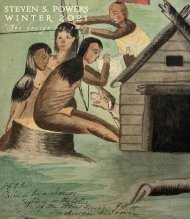
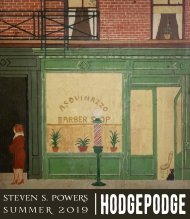
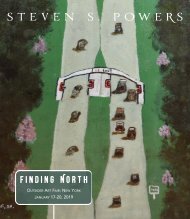

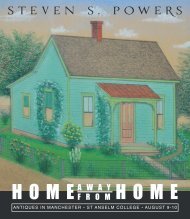
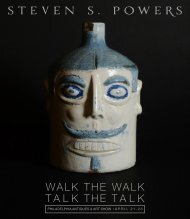
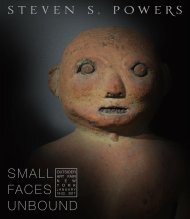
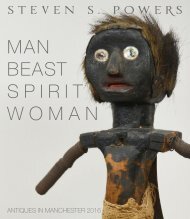
![NEEDLE • KNIFE • TORCH [&] BRUSH](https://img.yumpu.com/55309753/1/190x219/needle-o-knife-o-torch-brush.jpg?quality=85)
